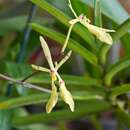Biology
provided by Arkive
Renanthera citrina grows on the bases on old, gnarled trees or moss-covered rocks. Cultivated plants are known to flower from December to February, but flowers have not been observed in the wild (2).
Conservation
provided by Arkive
More research into the status and distribution of this rare orchid is needed to assess its threat of extinction.
Description
provided by Arkive
This rare epiphytic orchid was only discovered as recently as the mid 1990s. As the specific name suggests this orchid has bright, lemon yellow flowers: citrina is derived from citrus (2). The tall inflorescence (flower stalk) may bear up to 10 exquisitely delicate flowers, which all bloom at once. The sepals at the base of the flower are broader than the other sepals and have a characteristic wavy edge (2). Both the sepals and the lip are marked with distinctive purple blotches (2). The leaves of this orchid are narrow and leathery; at up to 14 cm, they are longer than those of closely related species (2).
Habitat
provided by Arkive
Inhabits mountainous regions between 800 to 1,200 metres above sea level. Renanthera citrina is found in open, evergreen forests along the tops of limestone ridges (2).
Range
provided by Arkive
Found in northern Vietnam in the provinces of Cao Bang and Hoa Binh (2).
Status
provided by Arkive
Listed on Appendix II of CITES (3).
Threats
provided by Arkive
This attractive orchid is rare in the wild and under threat from deforestation, which is widespread in the area (2). The over-collection of plants for horticulture is also a severe threat to the survival of this species (4).

